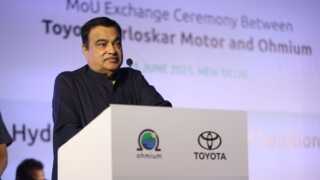Share via:
- At SIAM’s 65th convention, PM Modi hailed the auto sector as a pillar of Viksit Bharat and urged a shift to clean mobility. Nitin Gadkari struck a sobering note, stressing road safety, pollution control, scrappage, and lower logistics costs as urgent priorities.
…Read More For Union Minister Nitin Gadkari, it is not just an energy issue—it’s an economic, strategic, and environmental imperative (Mohd Nasir for HT Auto) Get Launch Updates on Notify me At the 65th annual convention of SIAM, Prime Minister Narendra Modi set the mood with a sweeping vision. The automobile industry, he said, is more than just cars and motorcycles, it is the torchbearer of Make in India, a key driver of growth, and a pillar of Viksit Bharat. His call was unmistakable: India must not just keep pace but lead the global shift to clean mobility. Electric vehicles, biofuels, startups, and energy storage were placed as the foundation stones of this journey. It was an inspiring message, one that drew applause from the industry’s top brass. But as the day unfolded, Union Minister Nitin Gadkari reminded everyone that the road ahead is not just about ambition, it is also about facing uncomfortable truths. Safety First, Still a Distant GoalFive lakh lives are lost on Indian roads every year. To put it differently, every minute, a family somewhere in India is shattered by a road accident. Gadkari did not sugarcoat it: unless safety becomes the first priority, every reform in mobility will ring hollow. The government has made moves, mandating six airbags, encouraging helmet use, and even enlisting cultural icons like Amitabh Bachchan and Prasoon Joshi to drive awareness. But behaviour is harder to legislate. Add to that a deficit of 22 lakh trained drivers, and the cracks widen. Gadkari’s recent initiatives, the ₹25,000 “Rahveer” award for rescuers and up to ₹1.5 lakh in hospital aid for victims, are empathetic steps, yet reactive in nature. Bharat NCAP was meant to change the narrative, giving buyers a chance to judge safety through crash-test ratings. But with many carmakers reluctant to highlight poor scores, progress has been hesitant. For a country that wants to be a global leader in mobility, this hesitation is telling. Also Read : Exports are the next engine for Indian automotive sector: Nitin Gadkari The Air We BreathePollution, Gadkari warned, is another silent emergency. 40 per cent of emissions come from transport. In Delhi, unchecked pollution could trim life expectancy by as much as a decade. Beyond the human toll, India also spends ₹22 lakh crore annually on importing fossil fuels. This is where the push for ethanol, maize-based fuels, hydrogen, and bio-CNG comes in. E20 fuel blending is already underway. But the larger challenge lies in scaling it up, supporting farmers, building supply chains, and convincing consumers. The Cost of Moving GoodsMobility is not just about cars and buses, it is about moving goods efficiently. India’s logistics costs hover around 10 per cent of GDP, far higher than China’s 7–8 per cent. Gadkari’s target is to bring this down to single digit by the end of 2025. Modern highways and direct freight trucking have helped, but the gaps remain. Unless road, rail, and ports integrate seamlessly, India’s export story will always be weighed down by cost. Scrappage: A Stalled PromiseOn paper, vehicle scrappage is a game-changer. In August 2025, India finally put three lakh vehicles to rest, 1.41 lakh of them from government fleets. It sounds impressive until you remember that nearly 97 lakh more are still waiting in the yard. The gains from a full-scale scrappage drive are not abstract. Seven lakh tonnes of imported steel could be saved, enough to build entire cities. The exchequer could earn ₹40,000 crore in GST. More importantly, it holds the promise of 70 lakh jobs and cleaner air, with the environmental dividend equal to planting 26 crore trees. Yet consumer response has been lukewarm. The reason is simple: automakers have not offered strong enough incentives for scrappage certificates. What should have been a win-win remains stuck in hesitation. Also Read : Future of transport would be built on electric vehicles, biofuels and hydrogen: Nitin Gadkari Industry at the CrossroadsAgainst this backdrop, SIAM president Shailesh Chandra highlighted record passenger vehicle sales of 4.3 million units and a nearly 15 per cent rise in exports. The cheer was real, but so were the concerns, two-wheeler sales still trail pre-Covid levels, and commercial vehicles are under pressure. Vice president Shenu Aggarwal praised schemes like FAME, PLI, and E-Bus Seva, and insisted that India has moved past “technological limitations.” Yet the industry knows the hurdles: localising EV components, dependence on rare earths, and the slow climb of hydrogen adoption. For India’s mobility story to truly align with Viksit Bharat, safety cannot remain an afterthought. Nor can pollution, logistics, or scrappage be treated as peripheral issues. The message from this year’s SIAM convention was clear: the ambition is vast, but the delivery deficit is equally vast. Unless that gap is bridged, India’s claim to global leadership in mobility will remain more aspiration than reality. Get insights into Upcoming Cars In India, Electric Vehicles, Upcoming Bikes in India and cutting-edge technology transforming the automotive landscape. First Published Date: 11 Sept 2025, 12:55 pm IST
Source: hindustantimes.com






